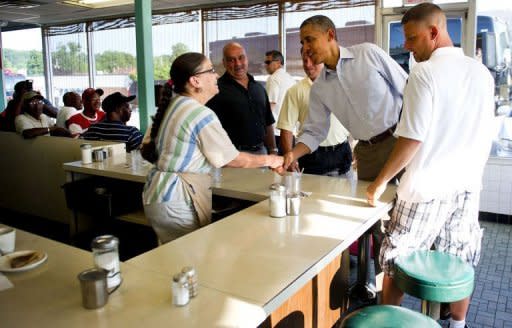US jobless rate stuck at 8.2% in June
The United States added 80,000 jobs in June, the third month of weak jobs growth amid a sluggish economy that has kept hiring on hold, Labor Department data showed Friday. The figure was far below what is needed just to keep pace with growth in the labor force, signaling no relief in sight for an unemployment rate that has held above 8.0 percent for more than three years. The disappointing report toughened the challenge ahead for President Barack Obama, who is fighting to keep his job in the November presidential election against charges by Republican challenger Mitt Romney that his administration has failed to revive the economy. The June jobless rate was unchanged from May at 8.2 percent, with 12.7 million people in the ranks of the unemployed. Four out of 10 were considered long-term unemployed, without jobs for at least 27 weeks. The private sector accounted for all of the jobs growth, creating 84,000 positions, while the public sector shed 4,000, continuing a downsizing trend as governments tighten budgets. Three years after the Great Recession, most analysts had forecast a stronger 100,000 jobs created. "The payroll change is a bad number that continues the recent trend. It suggests continued weak economic and earnings growth," said Dick Green at Briefing.com. But, he added, "it isn't a horrible number that portends recession." With the presidential election only four months away, the White House stressed that it was "important not to read too much into any one monthly report." "Employment is growing, but it is not growing fast enough given the jobs deficit caused by the deep recession, said Alan Krueger, chairman of Obama's Council of Economic Advisers. Krueger urged Congress to support job creation by ending tax breaks for companies that ship jobs overseas and spending to bolster state and local government hiring. Economists were divided over whether the slump in the employment market was bad enough to push the Federal Reserve into additional stimulus for the economy at its July 31-August 1 policy board meeting. "We do not believe today's report is sufficient to shift the Fed into action at the next FOMC meeting," Barclays analyst Michael Gapen said. Gapen noted that the Federal Open Market Committee had extended its bond-swap program to year-end at its June meeting, when the central bank slashed a half percentage point from its 2012 economic growth forecast to a tepid 2.4 percent rate at best. Nomura economists highlighted the risk that instead of a temporary soft patch this could be the beginning of a longer-lasting downshift in economic activity. "A persistent deterioration in labor market conditions would likely spur the Federal Reserve to adopt an even more accommodative stance," they said. The data showed a sharp slowdown in hiring across most major industries during the second quarter as the economy struggled to gain traction against pressures from Europe's debt crisis. The average number of jobs added in April, May and June was 75,000 jobs, only a third of the first quarter's pace. "June marked a third disappointing month for the labor market and the payback from strong winter hiring no longer figured in the results," said Sophia Koropeckyj at Moody's Analytics. Temporary services jobs surged by 25,200 in June, up from 18,600 in May. The retail sector was the hardest hit, shedding 5,400 jobs, as consumers shut their wallets. Analysts spotted a glimmer of silver lining in the data as the average number of hours worked and hourly earnings improved, pointing to a potential rebound in consumer spending which drives two-thirds of the economy. "As a result of the pickup in earnings and workweek, combined with the moderate rise in payrolls, aggregate wages rose 0.6 percent," Briefing.com analysts said. "That was the strongest gain since February when wages rose 0.8 percent and enough to support strong consumption growth in June."



